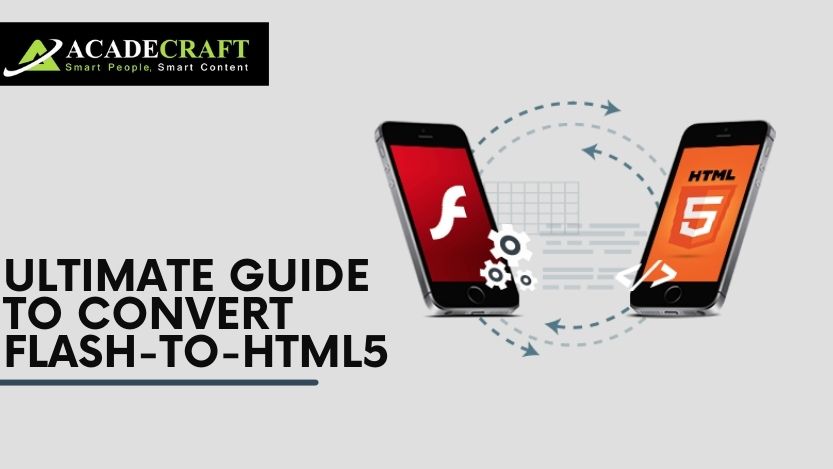Adobe Flash Player is a software with which all mobile, desktop applications and animations are produced. You can view Flash files using this software or third party players. This blog briefs you about HTML5, a markup language used for presenting content on the World Wide Web. It also highlights why you need to convert your flash content into HTML5 and mentions all steps. If you are finding it a technical burden, ask Flash to HTML5 Conversion Services to accomplish this task.
What is HTML5?
The latest and the 5th version of HyperText Markup Language (HTML) is a programming language used to create responsive web pages. It was released in 2014 and is maintained by several major browser vendors like Apple, Google, Mozilla, and Microsoft and Web Hypertext Application Technology Working Group (WHATWG).
Why convert Flash to HTML5?
The following reasons will make you convert the Flash content into HTML5.
- Flash may not sustain: In the future, web browsers like Google Chrome may disable the Flash plugin feature from their browser. Back in 2017, the parent company of Flash, Adobe had announced phasing out the Flash by the end of 2020. So, all the Flash videos, games, and websites need to be converted into another format. HTML5 is a convenient and accessible mode for netizens.
- Not supportive on a few platforms: Flash content is not supported by iPads, iPhones, and iOS devices, whereas HTML supports a more responsive design. With this software, you can use multimedia files on any platform.
- Security concern: Web security is the primary concern of this digital age. Hackers attack Flash websites and games quickly. Hence HTML5 is a secured option. It is not as vulnerable in terms of security as Flash is.
How to Convert Flash into HTML5?
Below we have mentioned a few of the e-Learning Authoring tools to use
Articulate Storyline: A helpful tool that converts your interactivities to resemble those in Flash.
Adobe Captivate: This tool converts the simulation of Flash into more responsive content.
iSpring Suite: to convert Powerpoint storyboards to courses incorporating visuals and assessments, this tool is required.
Lectora Online: This tool converts rich text Flash courses content into HTML5.
Conversion process
Follow these procedures to convert your Flash content into HTML5.
- Firstly, identify the Flash videos you want to convert into HTML5.
- Categorize the videos based on their relevancy and check their source files are available or not.
- Collect source files of all videos you want to convert. For instance, you may have video course content in .flv or another format. It means that your courses use graphics, interactivities, and other Flash components.
- Remove all relevant media content and content from these videos and store them in the appropriate folders.
- Select the appropriate conversion tool.
- Determine the Interactivity and graphical user interface (GUI) used in the converted video.
- Develop interactivity quickly by choosing the right template.
- Prefer Flash videos that need to be converted to HTML5. Priority factors may include importance, launch date, and necessity.
- Choose the correct conversion tactics for your videos. For instance, you want to convert the Flash content into HTML5 but don?t have access to source files or interactive elements; you can record it into MP4 format. To make your e-learning courses accessible on multiple platforms and devices, rebuild the courses with increasing interactivity. You can republish the older content with the authoring tool?s latest version.
- Develop and publish the converted HTM5 video content.
- Test its quality and functioning by running a quality check on multiple browsers or devices.
Final words
You need to follow these procedures for a smooth conversion and get updated with the latest tools for conversions. However, you can also connect with Professional Flash-to-HTML5 Conversion Services to get this task done. If you are running an e-Learning business, you can ask these expert solution services to convert your Flash content into HTML5.
